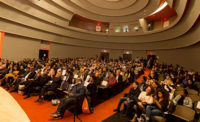When Less is More Earth-friendly
By reducing green design to a set of checklists that are then used as shopping lists, LEED and similar environmental rating systems may actually increase consumption. And by turning sustainability into the province of consultants, such systems take the responsibility for making buildings ecologically sound out of the hands of architects.

It didn’t have to be that way, Kevin Bone makes clear in this important new book. The outgrowth of a 2013 exhibition at New York’s Cooper Union, where Bone is the director of the Institute for Sustainable Design, it demonstrates that many significant Modernist buildings were green by virtue of their small size and sensitive siting. The format of the book is simple: 25 buildings are presented in photographs, renderings, and diagrams showing how the structures relate to sun position and prevailing winds.
The text is slight; it summarizes the relevant characteristics of each building, such as the shading effects of brises-soleil and the heating effects of thermal masses, succinctly. Alvar Aalto’s dwellings at Sunila, Finland, Bone writes, were designed “to take full advantage of the seasonal conditions,” while Frank Lloyd Wright’s Jacobs House II in Madison, Wisconsin, was “a precursor of the 1970s passive-solar movement.”
In a way, the book is as low-tech as the buildings it describes. Computer modeling, which could confirm the underlying ideas of Bone and his collaborators, wasn’t part of this project. But it doesn’t take such technologies to see that small buildings require fewer resources to build and operate. Two Paul Rudolph beach houses included in the book would barely qualify as gazebos in 2014.
“The very argument of Modernism that put forth a case for buildings stripped of excess” and that “declares one should use what one needs, and not more” is the essence of sustainable design, Bone writes. True, there were very un-green aspects to Modernism, including suburbanization and, with it, reliance on the automobile, as David Rifkind points out in an introductory essay. According to Rifkind, “Le Corbusier’s oeuvre demonstrates a paradox common to most of his contemporaries: a passionate concern with certain aspects of sustainability married to a curious disregard for others.” But what really broke the ties between Modernism and sustainability was air-conditioning. As it became affordable in the postwar years, Daniel A. Barber notes in his concluding essay, “the perceived need to mitigate the climatic impacts on building largely evaporated.” Now environmentalism has returned as a goal, but architects too often respond by adding green features to un-green buildings. Respect for the environment demands subtraction, not addition—knowing when to stop, not when to shop.





